Famous Paintings in the Louvre – The World Famous Gallery
Are the paintings in the Louvre real, and which paintings in the museum are considered iconic? The globally renowned Musée du Louvre is among the world’s top art museums to visit and a must-see for all art lovers. Transformed from a royal 14th century residence to the home of famous paintings by Leonardo da Vinci, Caravaggio, and Vermeer, there is much to louvre about the Louvre. In this article, we will explore the 25 most famous paintings on its walls that you simply must see on your first or next visit!
Contents
- 1 Exploring Art in the Louvre Museum
- 2 25 Famous Paintings in the Louvre
- 2.1 St. Sebastian (1480) by Andrea Mantegna
- 2.2 Virgin of the Rocks (1483 – 1486) by Leonardo da Vinci
- 2.3 Ship of Fools (c. 1490 – 1500) by Hieronymus Bosch
- 2.4 The Virgin and Child with Saint Anne (c. 1501 – 1519) by Leonardo da Vinci
- 2.5 Triumph of the Virtues (1502) by Andrea Mantegna
- 2.6 Mona Lisa (c. 1503 – 1506) by Leonardo da Vinci
- 2.7 Bacchus (1510 – 1515) by Leonardo da Vinci
- 2.8 Saint John the Baptist (c. 1513 – 1516) by Leonardo da Vinci
- 2.9 St. Michael Vanquishing Satan (1518) by Raphael
- 2.10 The Wedding at Cana (c. 1562 – 1563) by Paolo Veronese
- 2.11 The Fortune Teller (c. 1575/1600) by Caravaggio
- 2.12 Gabrielle d’Estrées et Une de ses Soeurs (1594) by Fontainebleau School Painter
- 2.13 Death of the Virgin (1606) by Caravaggio
- 2.14 The Astronomer (1668) by Johannes Vermeer
- 2.15 The Lacemaker (c. 1669 – 1670) by Johannes Vermeer
- 2.16 Portrait of Louis XIV in Coronation Robes (1701) by Hyacinthe Rigaud
- 2.17 Oath of the Horatii (1784) by Jacques-Louis David
- 2.18 The Intervention of the Sabine Women (1799) by Jacques-Louis David
- 2.19 Bonaparte Visits the Plague Stricken in Jaffa (1804) by Antoine-Jean Gros
- 2.20 The Coronation of Napoleon (c. 1805 – 1807) by Jacques-Louis David
- 2.21 The Charging Chasseur (c. 1812) by Théodore Géricault
- 2.22 Grande Odalisque (1814) by Jean-Auguste-Dominique Ingres
- 2.23 The Raft of the Medusa (c. 1818 – 1819) by Théodore Géricault
- 2.24 Liberty Leading the People (1830) by Eugène Delacroix
- 2.25 The Birds (1953) by George Braque
- 3 Frequently Asked Questions
Exploring Art in the Louvre Museum
There is more to the Louvre than meets its 673 glass-paneled pyramids or its image as portrayed in popular culture. The Musée du Louvre hosts some of the world’s most famous artworks, from sculptures of antiquity to Renaissance masterworks, the museum is a treasure trove of high-value art. The institution was originally a fortress built under King Philip II in 1190 and evolved through the hands of King Francis I and other monarchs to become the ultimate exhibition space for master artists. Additionally, one will also stumble upon the museum’s own school École du Louvre, which was established in 1882 and committed to the fields of art history, archaeology, epigraphy, and anthropology.

Are the paintings in the Louvre real? Certainly! With the institution’s tight security around the preservation of the paintings and while there have been replicas at the Louvre since its opening in 1753, many of the works are created by the original artists and anonymous followers of master artists. It might be an odd question to propose given the reputation of such a prestigious institution, however, there have been multiple debates and controversies around the display of fake artworks in many well-known art institutions.
Particularly of interest, in this respect, were reports with statistics claiming that up to 30% of paintings in major art institutions were fake, while others disagreed with this, given the rigorous authentication standards of museums like the Louvre.
25 Famous Paintings in the Louvre
Without further question or doubt, many unique and world-famous masterpieces have garnered attention for their technical qualities, historical significance, and affiliation with prominent artists. Below, we present 25 famous paintings in the Louvre that never fail to draw a crowd in.
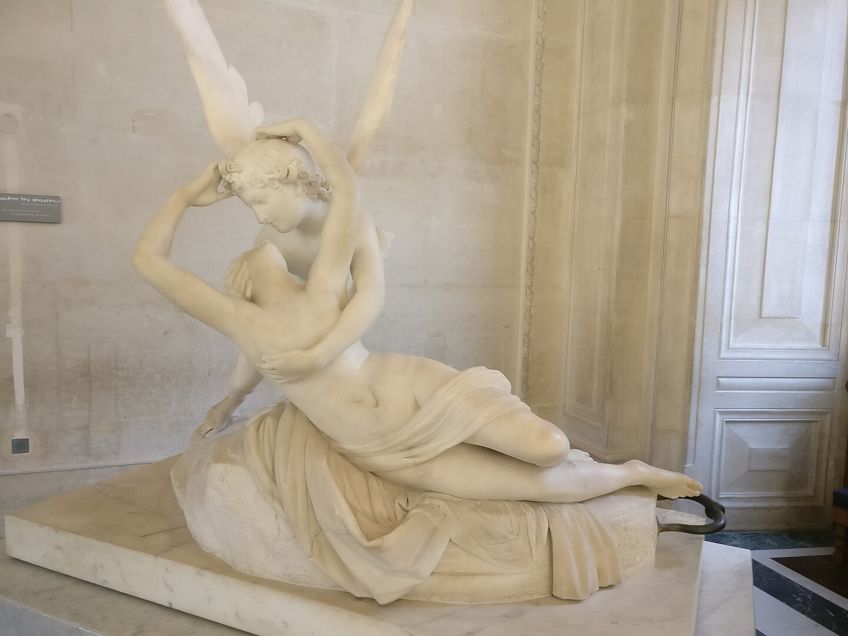
St. Sebastian (1480) by Andrea Mantegna
| Artist Name | Andrea Mantegna (1431 – 1506) |
| Date | 1480 |
| Medium | Oil on canvas |
| Dimensions (cm) | 255 x 140 |
A piece that marks the end of the plague in Padua, as well as the suffering of its artist Andrea Mantegna, St. Sebastian is among the most famous paintings at the Louvre. The theme of the work captures the narratives expressed in the Book of Revelation and portrays Saint Sebastian against an arch instead of the traditional use of a pole.
The most striking aspects of the work are the representation of the saint in an elegant pose and the backdrop of architectural precision that Mantegna gave to the antique city.
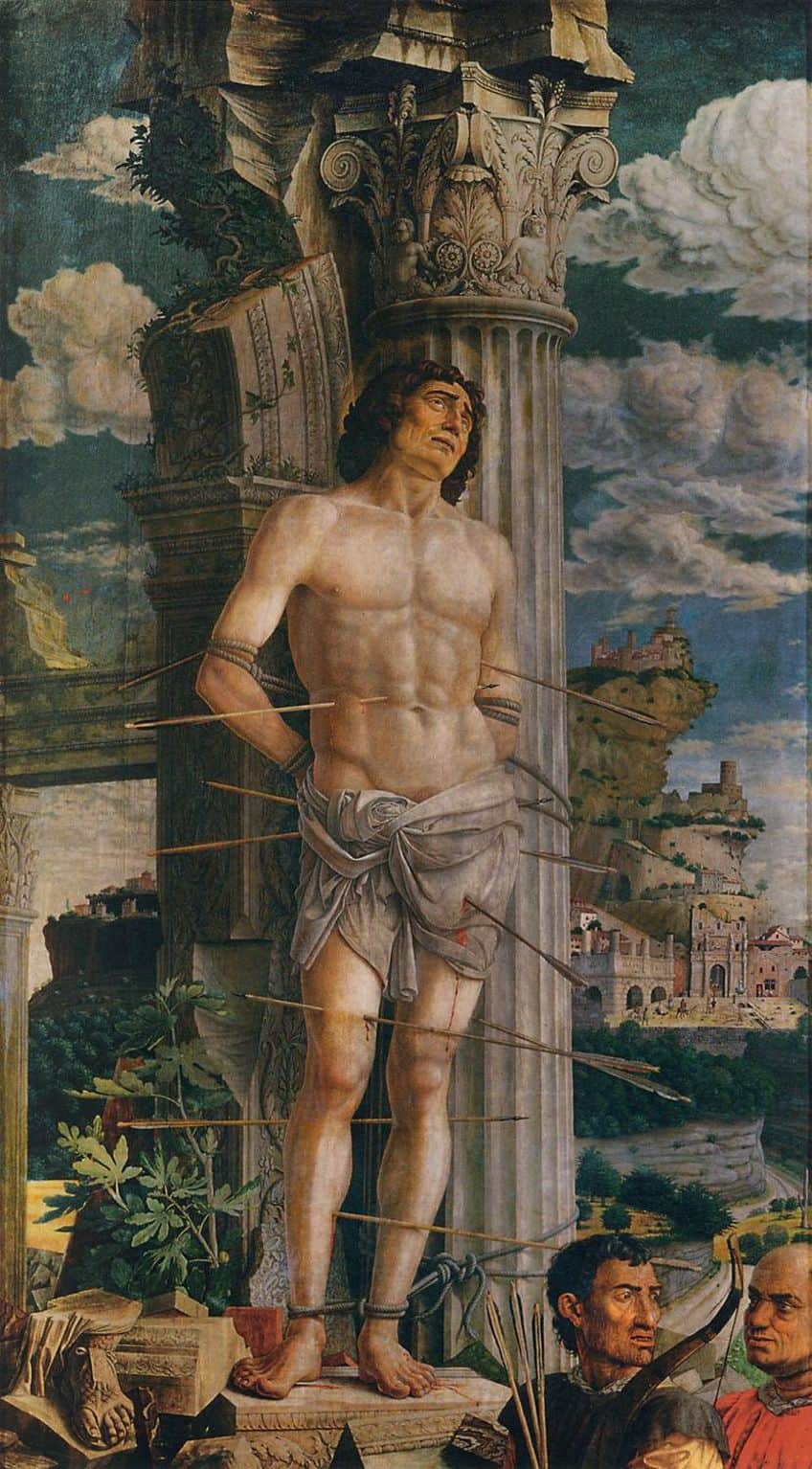
Virgin of the Rocks (1483 – 1486) by Leonardo da Vinci
| Artist Name | Leonardo da Vinci (1452 – 1519) |
| Date | 1483 – 1486 |
| Medium | Oil on panel transferred onto canvas |
| Dimensions (cm) | 199 x 122 |
Another hallmark painting by Da Vinci is among the top Louvre artworks that most followers of the master painter hope to see. This famous work is also known as Madonna of the Rocks and was created on a wooden panel but was later transferred onto canvas.
The Louvre version of the painting is identified as the first painting out of two copies, one of which was restored and remains at the National Gallery in London.
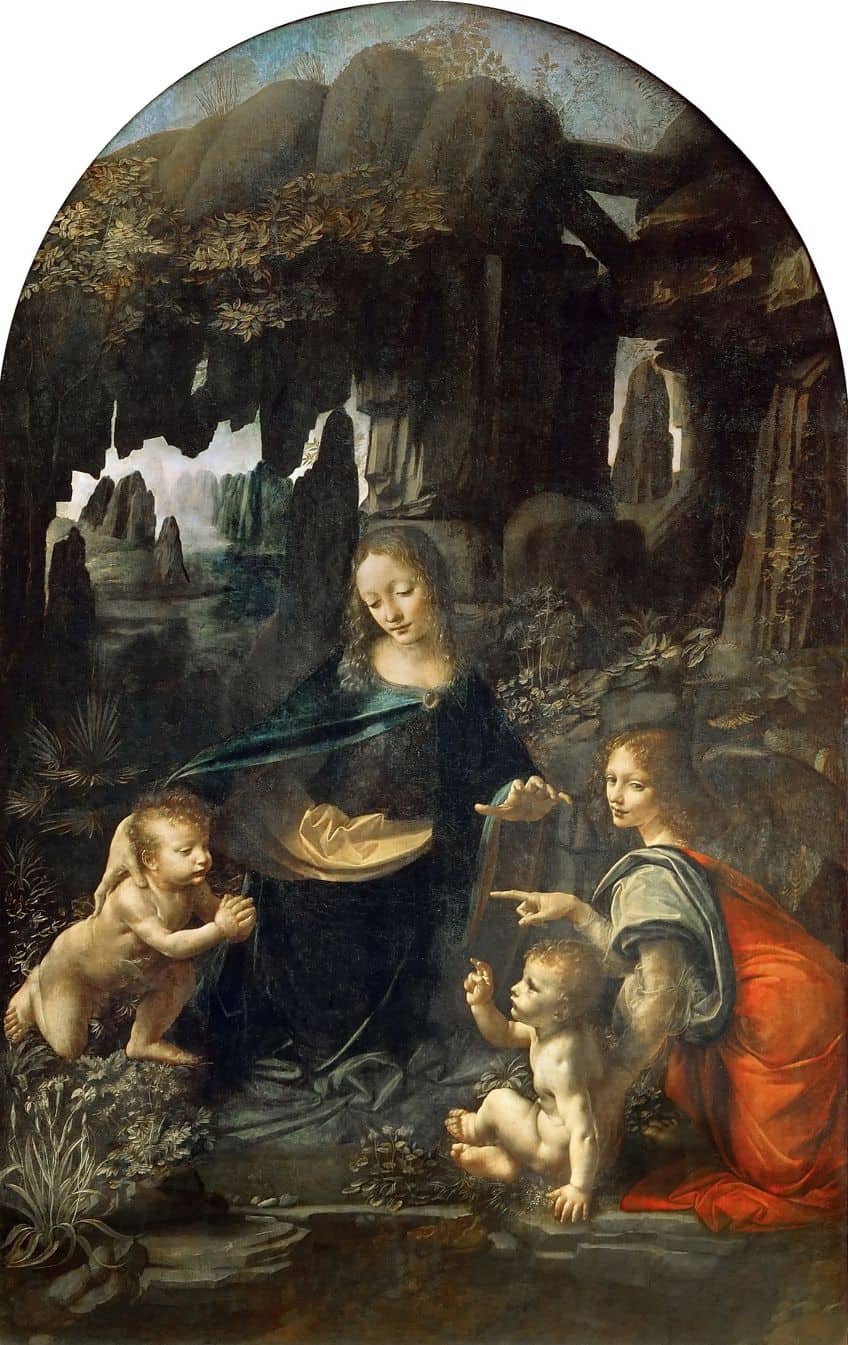
Ship of Fools (c. 1490 – 1500) by Hieronymus Bosch
| Artist Name | Hieronymus Bosch (c. 1450 – 1516) |
| Date | c. 1490 – 1500 |
| Medium | Oil on wood |
| Dimensions (cm) | 58 x 33 |
If you are a fan of Hieronymus Bosch, then Ship of Fools might be the first painting you want to look for at the Louvre. Ship of Fools is among the most famous Louvre artworks and is one of 25 paintings in the world credited to the Netherlandish painter.
The painting was donated to the museum in 1918 and remained in its care, surviving a restoration in 2015.
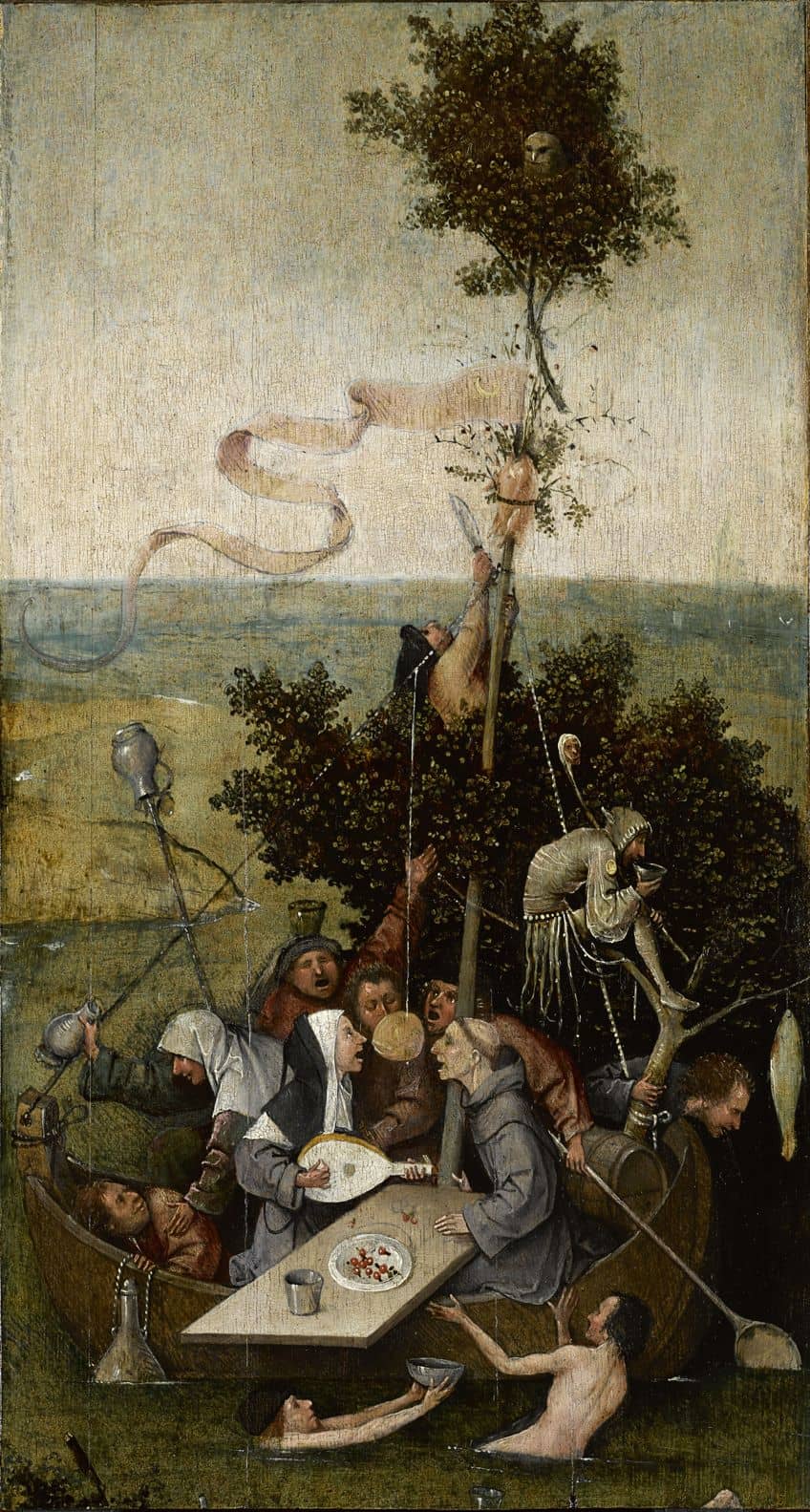
The Virgin and Child with Saint Anne (c. 1501 – 1519) by Leonardo da Vinci
| Artist Name | Leonardo da Vinci (1452 – 1519) |
| Date | c. 1501 – 1519 |
| Medium | Oil on wood |
| Dimensions (cm) | 130 x 168.4 |
Believed to be a commissioned work by King Louis XII of France, The Virgin and Child with Saint Anne was painted by Da Vinci between 1501 and 1519 to portray a scene with Saint Anne and her daughter, Mary.
Christ is depicted as an infant grasping onto a sacrificial lamb, symbolic of the Passion of Christ.
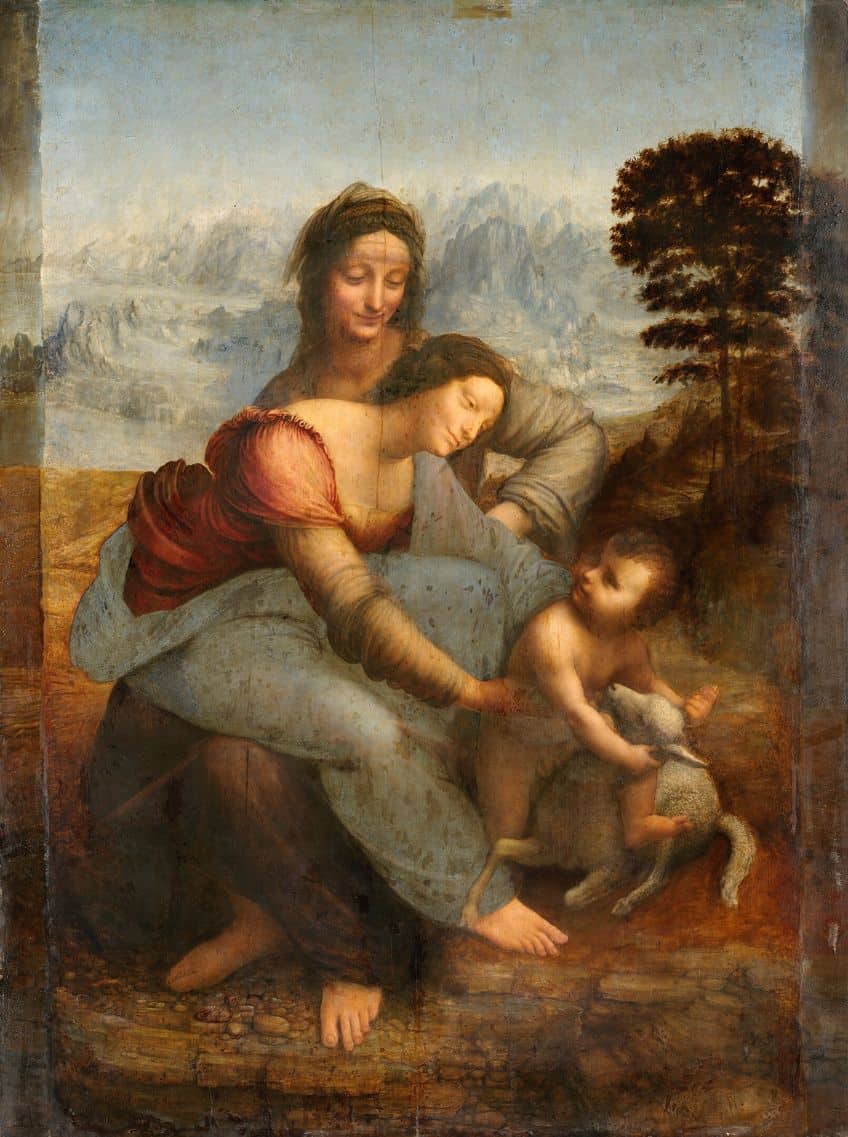
Triumph of the Virtues (1502) by Andrea Mantegna
| Artist Name | Andrea Mantegna (1431 – 1506) |
| Date | 1502 |
| Medium | Tempera on canvas |
| Dimensions (cm) | 160 x 192 |
Famous early 16th-century Italian painter Andrea Mantegna created this famous painting titled Triumph of the Virtues for one of the most prominent and influential cultural leaders of the Renaissance, Isabella d’Este, in 1502. The painting represents the mythological figures Minerva and Diana in a heroic attempt to save the goddess of chastity from the evil intentions of the Centaur.
One can also identify the three virtues in the sky, representative of Fortitude, Justice, and Temperance.

Mona Lisa (c. 1503 – 1506) by Leonardo da Vinci
| Artist Name | Leonardo da Vinci (1452 – 1519) |
| Date | c. 1503 – 1506 |
| Medium | Oil on poplar panel |
| Dimensions (cm) | 77 x 53 |
The Mona Lisa painting is by far one of the world’s most famous paintings that almost every visitor to the Louvre rushes to see. Da Vinci created this masterpiece between 1503 and 1506, with no knowledge that it would become one of the world’s most loved, talked-about, and referenced paintings.
The model that Da Vinci chose to paint was Lisa del Giocondo for her husband Francesco del Giocondo, who was a prominent silk merchant.
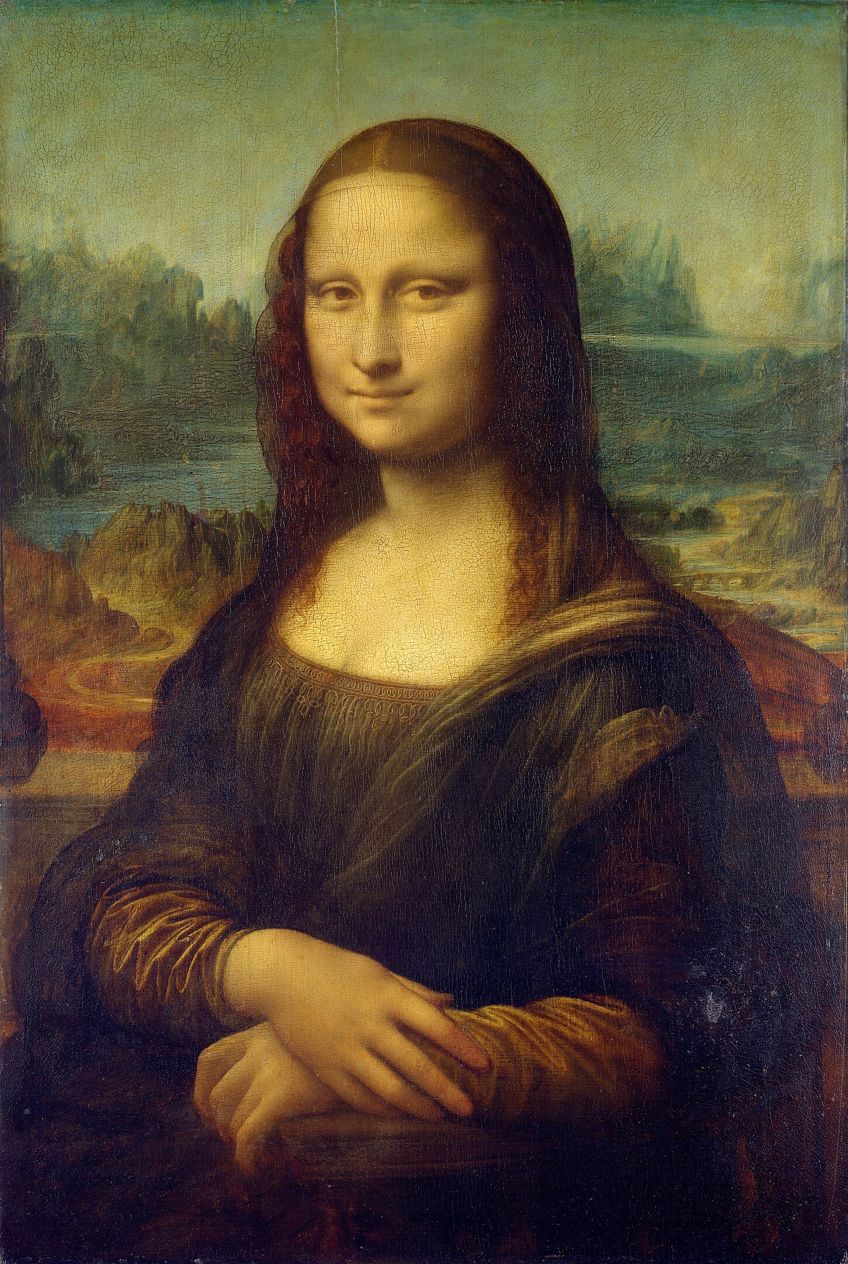
Bacchus (1510 – 1515) by Leonardo da Vinci
| Artist Name | Leonardo da Vinci (1452 – 1519) |
| Date | 1510 – 1515 |
| Medium | Oil on walnut panel transferred to canvas |
| Dimensions (cm) | 177 x 115 |
Previously known as Saint John the Baptist, Bacchus is a famous Louvre painting by Leonardo da Vinci that was created during his second stay in Milan. The painting depicts a male figure seated in an idyllic landscape wearing a garland on his head and dressed in leopard skin. The symbolic nature of the work is what stimulates the curiosity and intrigue toward the painting since Da Vinci portrayed the figure as pointing in different directions, with one hand pointing toward the earth below and one hand pointing in the direction of his staff.
The painting originally depicted St. John the Baptist but was overpainted into a pagan deity named Bacchus, who was the god of intoxication and wine.
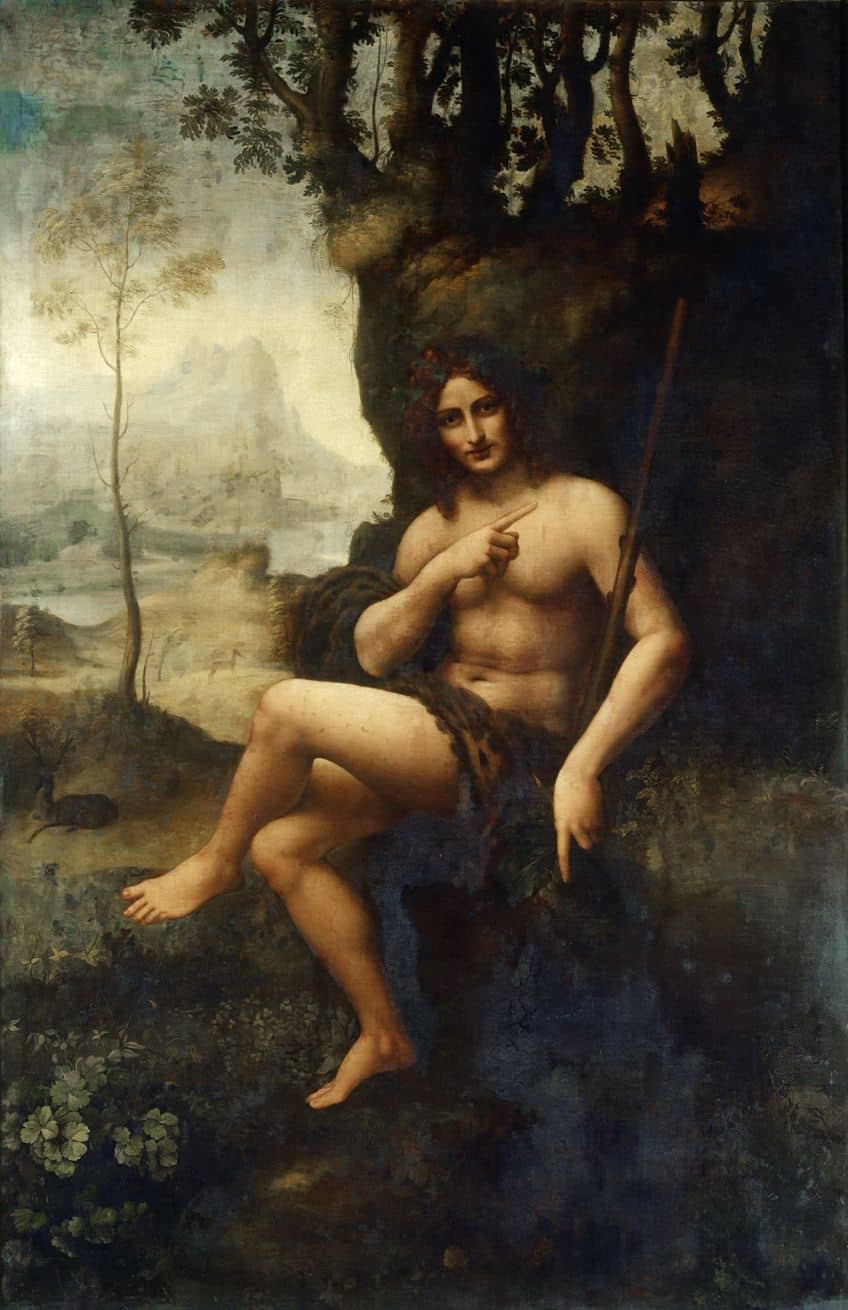
Saint John the Baptist (c. 1513 – 1516) by Leonardo da Vinci
| Artist Name | Leonardo da Vinci (1452 – 1519) |
| Date | c. 1513 – 1516 |
| Medium | Oil on walnut wood |
| Dimensions (cm) | 69 x 57 |
A prime example of chiaroscuro painting by Leonardo da Vinci, this famous Louvre painting is recognized as the artist’s final artwork before his death and was recently loaned to the Louvre Abu Dhabi in 2022. The isolated figure of John the Baptist emerges from the shadows with his finger pointing toward heaven, presented in a sfumato overcast.
Similar to Da Vinci’s other works, he managed to evoke the relationships between the body and the spirit while presenting the saint in an androgynous light.
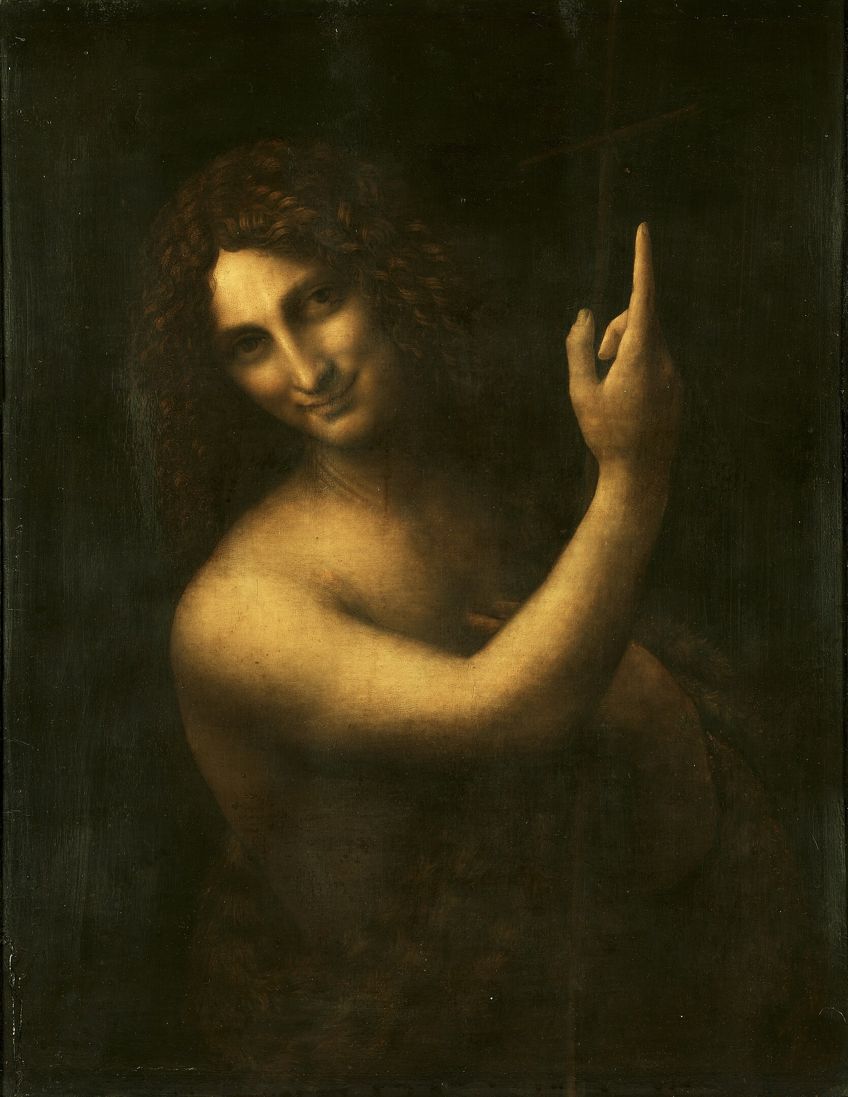
St. Michael Vanquishing Satan (1518) by Raphael
| Artist Name | Raffaello Sanzio da Urbino (1483 – 1520) |
| Date | 1518 |
| Medium | Oil transferred from wood to canvas |
| Dimensions (cm) | 268 x 160 |
Commissioned by Pope Leo X in the 16th century, this iconic and biblically inspired painting was created by the prodigy painter Raphael to represent the triumph over evil. The striking image depicts the figure of archangel Michael at the moment when he is about to pierce Satan with a spear. As many will recognize, Raphael was an extremely talented artist, who knew his way through the 16th-century art world.
He draws from his father’s experience as an artist to even stand his ground against those in authority.
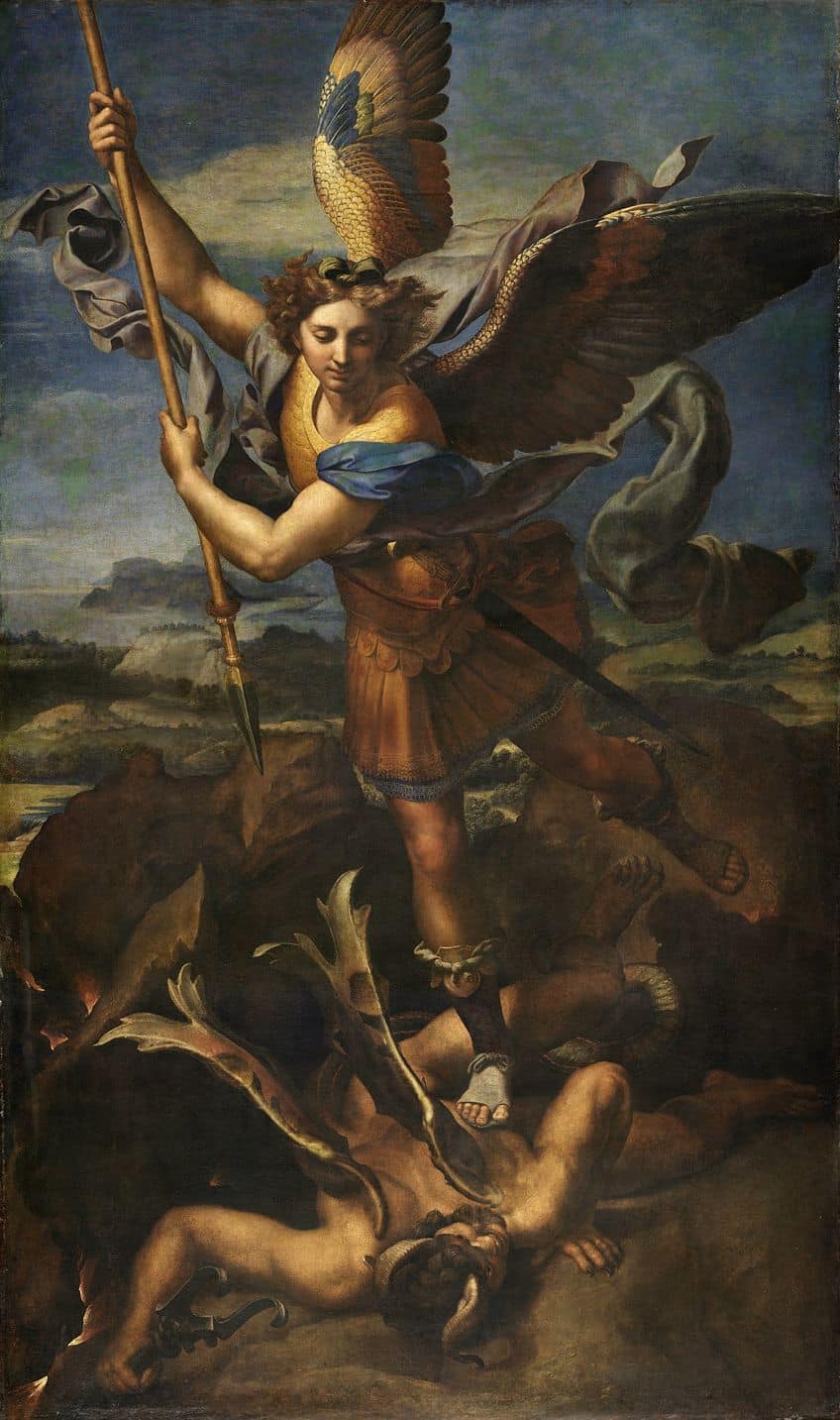
The Wedding at Cana (c. 1562 – 1563) by Paolo Veronese
| Artist Name | Paolo Veronese (1528 – 1588) |
| Date | c. 1562 – 1563 |
| Medium | Oil on canvas |
| Dimensions (cm) | 677 x 994 |
Also known as Nozze di Cana, this famous representational painting was created by Italian painter Paolo Veronese between 1562 and 1563. The painting depicts a scene from the biblical wedding known as the Wedding at Cana, where Jesus Christ transforms the water into wine.
The large-scale Mannerist painting demonstrates the artist’s exaggeration of Renaissance ideals through a flattened pictorial space and an idealistic representation of the subject.

The Fortune Teller (c. 1575/1600) by Caravaggio
| Artist Name | Michelangelo Merisi da Caravaggio (1571 – 1610) |
| Date | c. 1575/1600 |
| Medium | Oil on canvas |
| Dimensions (cm) | 99 x 131 |
The Fortune Teller by Caravaggio is one of the most famous Louvre paintings from the Cardinal del Monte collection in Rome. The painting is one of two copies that depicts a young man having his fortune read by a Romani woman, who was guilty of deceit, but charmed the man with her smile.
A poet by the name of Gaspare Murtola once observed the dual nature of the painting and the representation of deceit by comparing Caravaggio’s painting style to the work of sorcery as he portrayed the woman with such vitality.
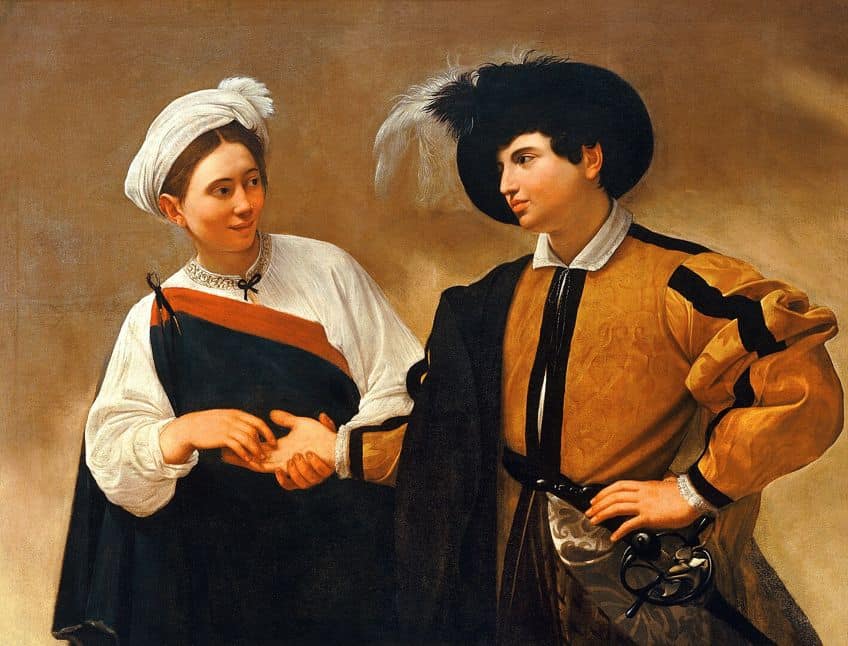
Gabrielle d’Estrées et Une de ses Soeurs (1594) by Fontainebleau School Painter
| Artist Name | Unknown artist from Fontainebleau School |
| Date | 1594 |
| Medium | Oil on wood |
| Dimensions (cm) | 96 x 125 |
Gabrielle d’Estrées et Une de ses Soeurs is perhaps one of the most intriguing paintings from the Louvre’s collection. The painting’s creator remains a mystery, however, it is believed to have been created by an unknown artist from the Fontainebleau School around 1594. The subject of the painting revolves around Gabrielle d’Estrées, who was King Henry IV’s mistress sitting in a bathtub alongside her nude sister Julienne-Hyppolite-Joséphine, who appears to pinch her nipple.
The theme of the work was also set against the announcement of the conception of César de Bourbon, the French King’s illegitimate child.
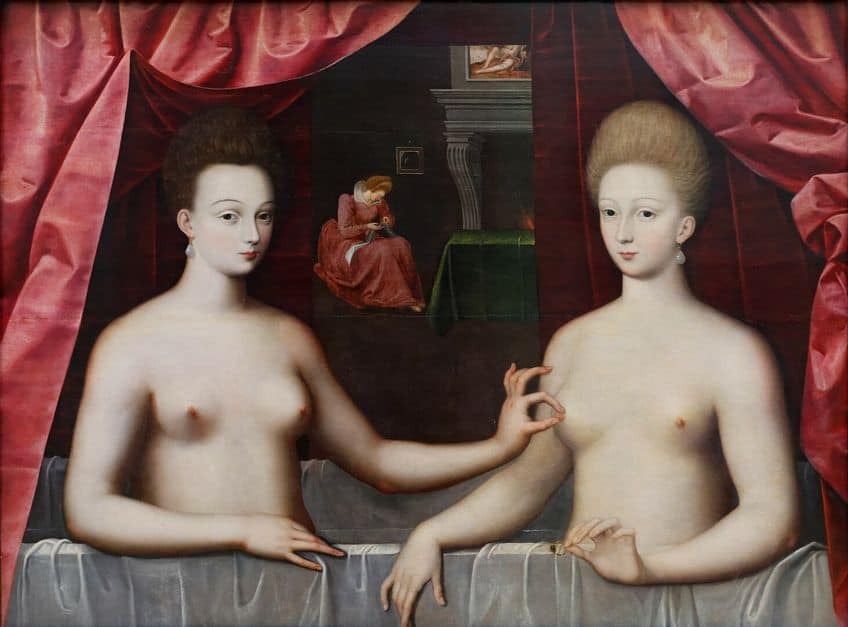
Death of the Virgin (1606) by Caravaggio
| Artist Name | Michelangelo Merisi da Caravaggio (1571 – 1610) |
| Date | 1606 |
| Medium | Oil on canvas |
| Dimensions (cm) | 369 x 245 |
Death of the Virgin is another popular Louvre artwork that was created by the master Baroque painter Caravaggio in 1606. The painting is part of the museum’s permanent collection and depicts the death of the Virgin Mary, as commissioned by a papal lawyer Laerzio Cherubini. The painting generated significant attention after it was rumored to have been created using a prostitute as a model for the face of Mary.
This led to Caravaggio’s work being rejected and replaced by the work of his follower Carlo Saraceni.
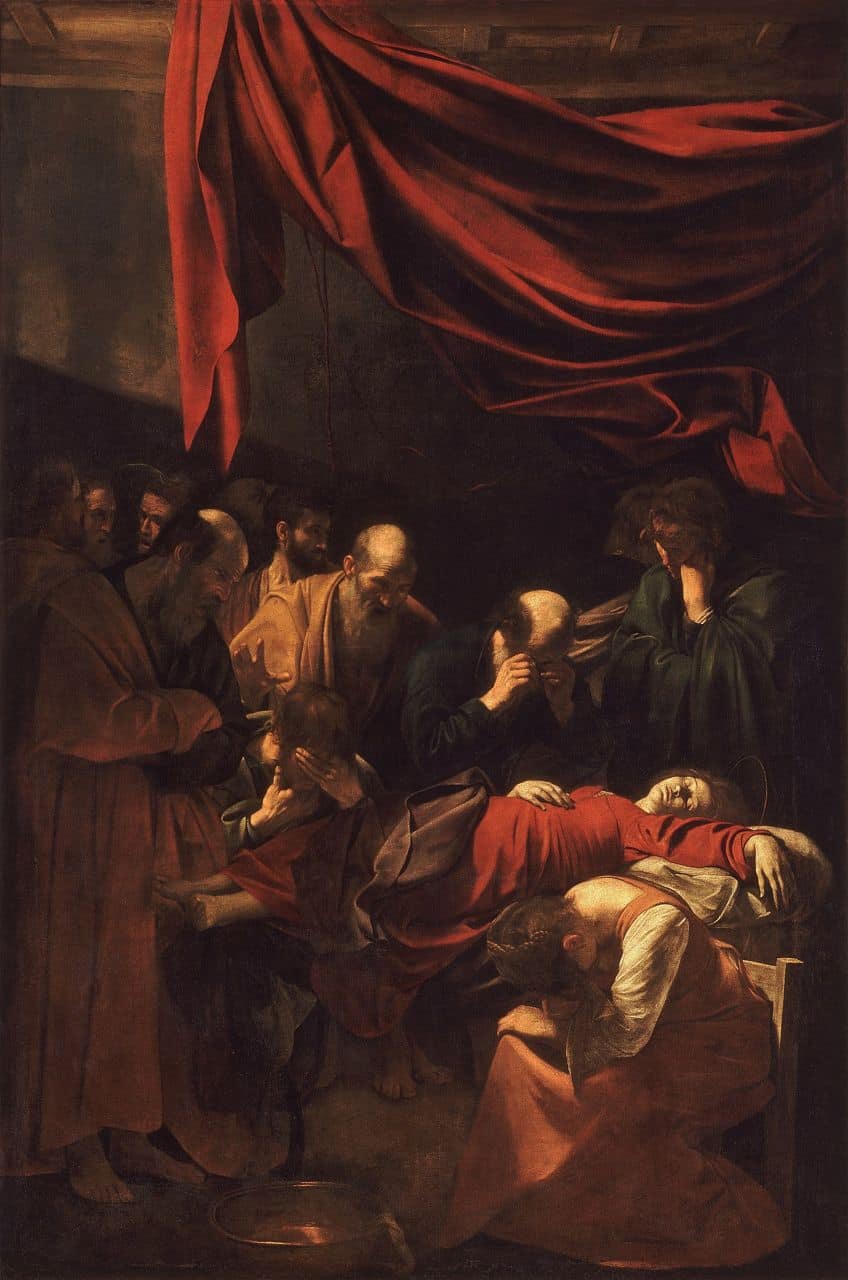
The Astronomer (1668) by Johannes Vermeer
| Artist Name | Johannes Vermeer (1632 – 1675) |
| Date | 1668 |
| Medium | Oil on canvas |
| Dimensions (cm) | 51 x 45 |
Capturing the essence of Dutch painting preferences in the 17th century, this famous Johannes Vermeer painting was created during a period that favored scientific representation. The painting is believed to portray Antonie van Leeuwenhoek, a Dutch microbiologist, studying a celestial globe.
The painting was previously owned by the Rothschild family and acquired by the French state in 1983.

The Lacemaker (c. 1669 – 1670) by Johannes Vermeer
| Artist Name | Johannes Vermeer (1632 – 1675) |
| Date | c. 1669 – 1670 |
| Medium | Oil on canvas |
| Dimensions (cm) | 24.5 x 21 |
This mature 17th-century masterpiece was created by none other than Johannes Vermeer between 1669 and 1670 and depicts a lacemaker dressed in a yellow bodice, engaged in her practice.
The famous Vermeer painting is believed to have been created using a camera obscura, which Vermeer possibly employed to draw our attention to the depth of field and place the subject in focus.

Portrait of Louis XIV in Coronation Robes (1701) by Hyacinthe Rigaud
| Artist Name | Hyacinthe Rigaud (1659 – 1743) |
| Date | 1701 |
| Medium | Oil on canvas |
| Dimensions (cm) | 277 x 194 |
This famous Louvre painting is recognized as the most famous image of King Louis XIV of France, also known as the Sun King, and was created in 1701 by Hyacinthe Rigaud. Multiple copies of the portrait can be found at the Versailles Palace, as well as the J. Paul Getty Museum and the Paris Observatory, produced by another artist.
Rigaud was a Catalan-French painter, who was identified as Jacint Rigau-Ros i Serra and was a preferred portrait artist for many French nobles.
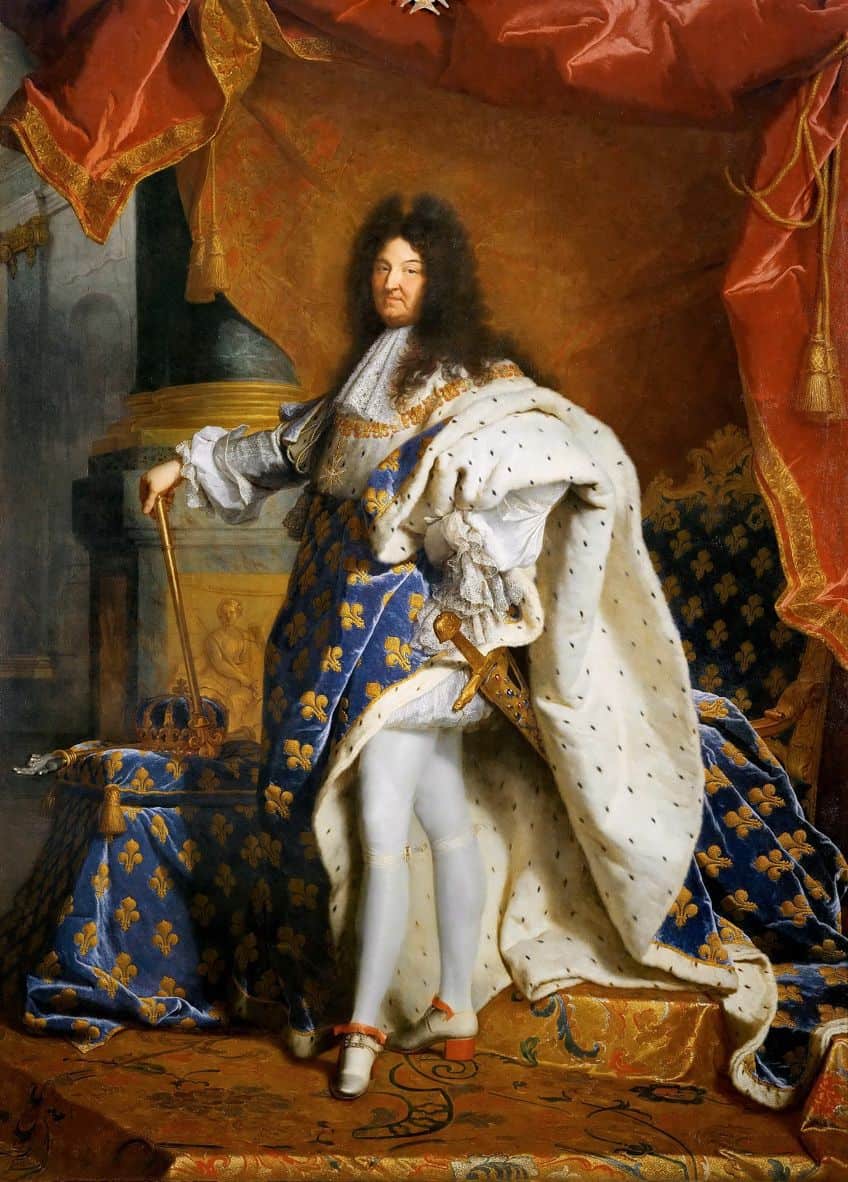
Oath of the Horatii (1784) by Jacques-Louis David
| Artist Name | Jacques-Louis David (1748 – 1825) |
| Date | 1784 |
| Medium | Oil on canvas |
| Dimensions (cm) | 329.8 x 424.8 |
The most iconic painting of the Neoclassical era, the Oath of the Horatii is one of the most famous Louvre artworks that was created by Jacques-Louis David in 1784. The painting depicts a conflict between the warring cities of Alba Longa and Rome, as described by a 7th-century legend that highlights the significance of hypermasculinity through self-sacrifice for one’s own home country. The three brothers fighting on behalf of Rome were from the Horatii family and were up against three men from the Curiatii family.
According to the story, only one out of the three Horatii brothers survived, and miraculously took down his three opponents.

The Intervention of the Sabine Women (1799) by Jacques-Louis David
| Artist Name | Jacques-Louis David (1748 – 1825) |
| Date | 1799 |
| Medium | Oil on canvas |
| Dimensions (cm) | 385 x 522 |
Since its debut in 1799, The Intervention of the Sabine Women has attracted countless visitors for its historical depiction of the abduction of Sabine women by the founding Romans. The creation of the work revolved around the artist’s expression of love amid conflict after his wife visited him in jail and moved him to spend four years creating the painting in her honor.
David was imprisoned for being a follower of Robespierre.

Bonaparte Visits the Plague Stricken in Jaffa (1804) by Antoine-Jean Gros
| Artist Name | Antoine-Jean Gros (1771 – 1835) |
| Date | 1804 |
| Medium | Oil on canvas |
| Dimensions (cm) | 532 x 720 |
Immortalizing a scene from the French invasion of Egypt, Bonaparte Visits the Plague Stricken in Jaffa is among the most famous artworks at the Louvre, painted by Antoine-Jean Gros in 1804. The famous oil painting was commissioned by the French Emperor Napoleon Bonaparte himself to portray his visit to the Levantine city of Jaffa in 1799.
The painting remains, in retrospect, a symbol of propaganda to ease the atrocities committed during the invasion.
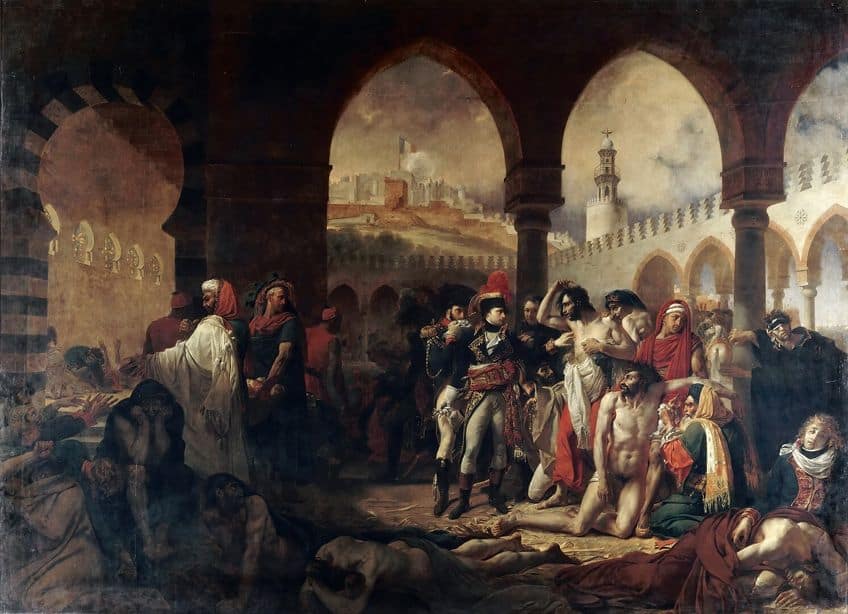
The Coronation of Napoleon (c. 1805 – 1807) by Jacques-Louis David
| Artist Name | Jacques-Louis David (1748 – 1825) |
| Date | c. 1805 – 1807 |
| Medium | Oil on canvas |
| Dimensions (cm) | 621 x 979 |
In 1804, Napoleon commissioned his official painter Jacques-Louis David to paint his coronation, which was completed in 1807. The painting depicts Bonaparte’s coronation at the Notre Dame de Paris and was co-painted by Georges Rouget, who was David’s student. This famous artwork was previously held in the Palace of Versailles and was later transferred to the Louvre in 1889.
Apart from Napoleon, other figures represented in the painting include Louis Bonaparte, Joachim Murat, Halet Efendi, and the artist himself.
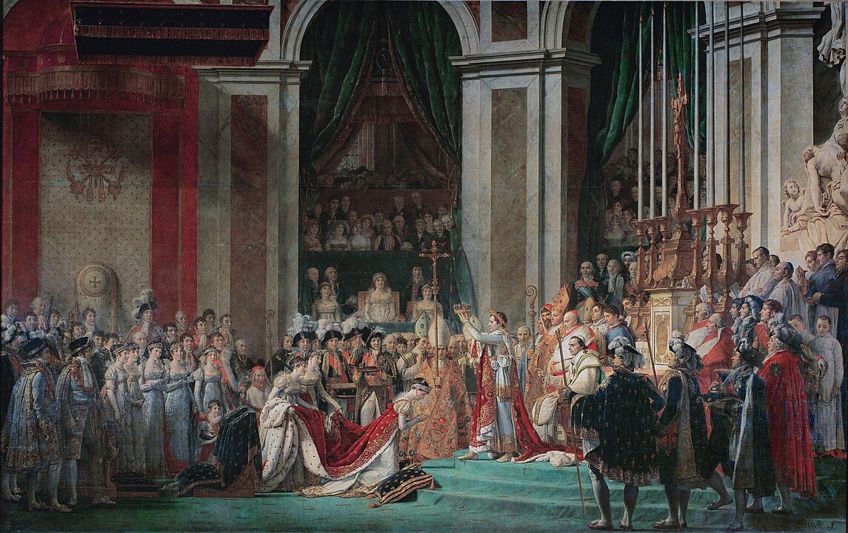
The Charging Chasseur (c. 1812) by Théodore Géricault
| Artist Name | Théodore Géricault (1791 – 1824) |
| Date | c. 1812 |
| Medium | Oil on canvas |
| Dimensions (cm) | 349 x 266 |
This famous painting of a horse galloping away as its rider twists his body to face the unseen opponent is one of the most famous paintings in the Louvre. Created around 1812 by French painter and printmaker Théodore Géricault, this work is among the most renowned images of a Napoleonic cavalry officer.
This later inspired the contemporary painter Kehinde Wiley to create Officer of the Hussars (2007) after the subject of the original work.

Grande Odalisque (1814) by Jean-Auguste-Dominique Ingres
| Artist Name | Jean-Auguste-Dominique Ingres (1780 – 1867) |
| Date | 1814 |
| Medium | Oil on canvas |
| Dimensions (cm) | 88.9 x 162.56 |
In a display of erotic Romanticism, this famous nude study by Jean-Auguste-Dominique Ingres is among the most well-known paintings at the Louvre Museum. The painting was created in 1814 and shocked critics after it exposed its style with a lack of realism and elongated body proportions on the woman’s figure.
The nude artwork was commissioned by Queen Caroline Murat, who was Napoleon’s sister and was inspired by the works of master artists Titian and Giorgione.
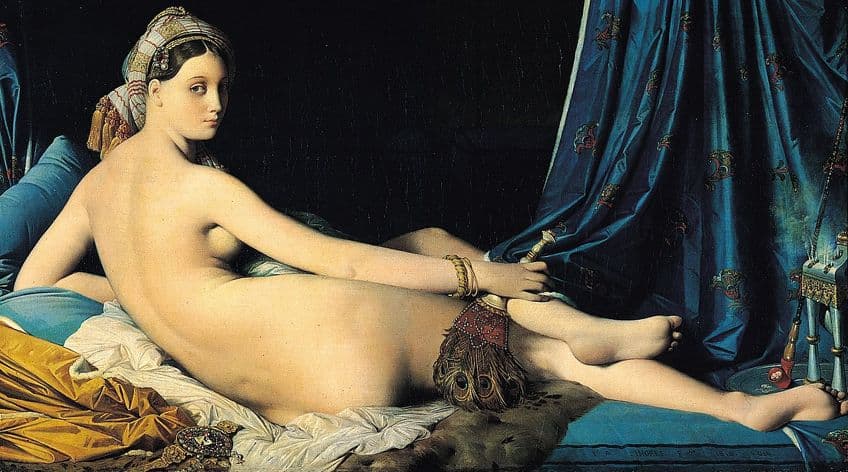
The Raft of the Medusa (c. 1818 – 1819) by Théodore Géricault
| Artist Name | Théodore Géricault (1791 – 1824) |
| Date | c. 1818 – 1819 |
| Medium | Oil on canvas |
| Dimensions (cm) | 490 x 716 |
Originally identified as Scène de Naufrage, The Raft of the Medusa is one of the Louvre’s most famous paintings created between 1818 and 1818 by Théodore Géricault. The massive oil painting is widely recognized as a symbol of French Romantic painting that captured the shipwreck of the French naval ship Méduse in 1816. The aftermath of the wreck forced survivors to endure dehydration and resort to cannibalism, which contributed to the global controversy around the captain’s competency. Géricault created the work after interviewing two survivors of the incident and creating many preparatory sketches.
The painting remains an iconic history painting that was acquired soon after Géricault’s death at 32 years old.
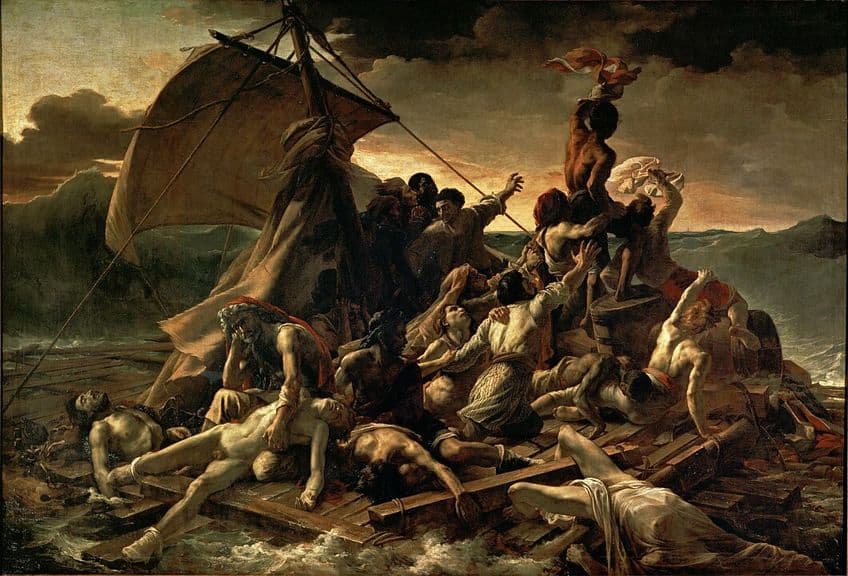
Liberty Leading the People (1830) by Eugène Delacroix
| Artist Name | Eugène Delacroix (1798 – 1863) |
| Date | 1830 |
| Medium | Oil on canvas |
| Dimensions (cm) | 260 x 325 |
This incredibly famous painting is one of the Louvre’s most visited paintings that depicts the July Revolution that defeated King Charles X in 1830. The iconic image has also been referenced frequently across popular culture and is often mistaken for depicting the French Revolution. The woman who dominates the composition is the personification of Liberty, as she waves the tricolor flag proudly above the pile of dead bodies around her.
The artist behind the work was Eugène Delacroix, a pioneer of the French Romantic School.

The Birds (1953) by George Braque
| Artist Name | George Braque (1882 – 1963) |
| Date | 1953 |
| Medium | Oil on canvas |
| Dimensions (cm) | 207 x 212 |
Located in room 662, this famous George Braque painting was created in 1953 for 10 million francs as a replacement for Blondel’s ceiling. The painting depicts two birds against a blue background outlined in a band of white for a stylized effect. The oval artwork brings a splash of color to the room and encourages one to look up at the larger-than-life birds.
We hope that you have enjoyed discovering the most famous Louvre paintings to date. The next time you plan a trip to the Louvre, you can rest assured that you will be better prepared to find the artworks that you simply must see!
Frequently Asked Questions
What Is the Most Famous Painting in the Louvre?
Mona Lisa (c. 1503 – 1506) is the most famous painting in the Louvre Museum. The renowned oil painting was created by High Renaissance polymath Leonard da Vinci and was modeled after Lisa del Giocondo.
What Is the Largest Painting in the Louvre?
The Wedding at Cana (c. 1562 – 1563) is recognized as the largest painting in the Louvre Museum. The artwork was created by Paolo Veronese and measures up to nine meters in length.
What Is the Most Expensive Painting in the Louvre?
Mona Lisa (c. 1503 – 1506) is identified as the most expensive painting in the Louvre Museum, since it is valued at around $860 million today.
Jordan Anthony is a Cape Town-based film photographer, curator, and arts writer. She holds a Bachelor of Art in Fine Arts from the University of the Witwatersrand, Johannesburg, where she explored themes like healing, identity, dreams, and intuitive creation in her Contemporary art practice. Jordan has collaborated with various local art institutions, including the KZNSA Gallery in Durban, the Turbine Art Fair, and the Wits Art Museum. Her photography focuses on abstract color manipulations, portraiture, candid shots, and urban landscapes. She’s intrigued by philosophy, memory, and esotericism, drawing inspiration from Surrealism, Fluxus, and ancient civilizations, as well as childhood influences and found objects. Jordan is working for artfilemagazine since 2022 and writes blog posts about art history and photography.
Learn more about Jordan Anthony and about us.
Cite this Article
Jordan, Anthony, “Famous Paintings in the Louvre – The World Famous Gallery.” artfilemagazine – Your Online Art Source. January 16, 2024. URL: https://artfilemagazine.com/famous-paintings-in-the-louvre/
Anthony, J. (2024, 16 January). Famous Paintings in the Louvre – The World Famous Gallery. artfilemagazine – Your Online Art Source. https://artfilemagazine.com/famous-paintings-in-the-louvre/
Anthony, Jordan. “Famous Paintings in the Louvre – The World Famous Gallery.” artfilemagazine – Your Online Art Source, January 16, 2024. https://artfilemagazine.com/famous-paintings-in-the-louvre/.



